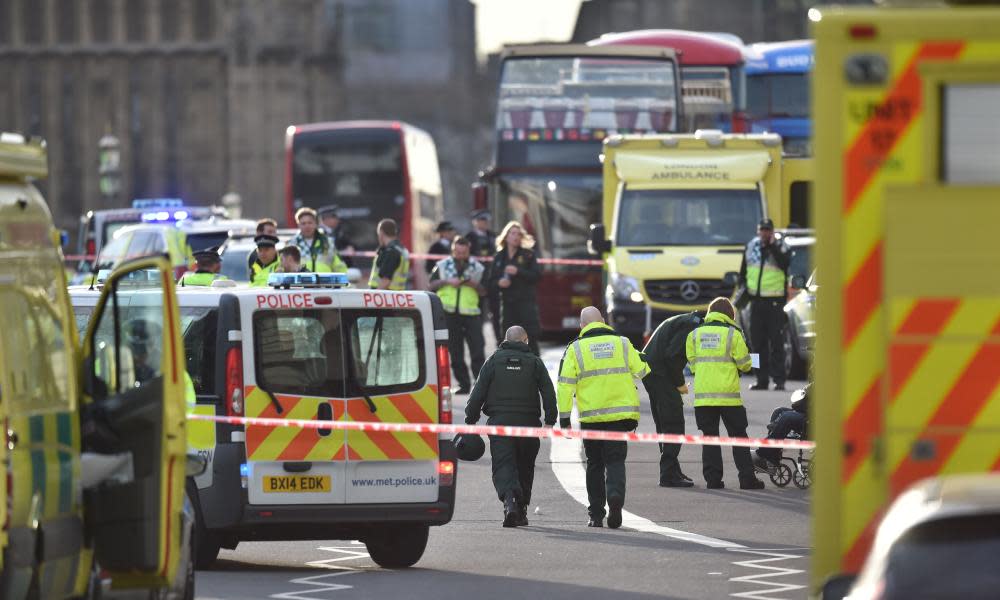London attack: what we know so far

The investigation into a terrorist attack outside the Houses of Parliament in London is continuing.
Here is what the Guardian has been able to confirm:
Five people have died, including a police officer and the attacker.
Police say at least 50 people were injured, with 31 requiring hospital treatment. Two of these remain in a critical condition, one of whom has life-threatening injuries. Two police officers are among those still in hospital.
The assailant was Khalid Masood, 52, who was born in Kent with the birth name Adrian Russell Ajao. He was believed to have been living recently in the West Midlands.
He drove a car into pedestrians on Westminster Bridge, killing three people – two of whom died at the scene and one who died of his injuries in hospital – before crashing it outside parliament and trying to enter the building, armed with two knives.
He stabbed an unarmed police officer who later died from the injuries. Police then shot the attacker. The dead officer was identified as PC Keith Palmer, 48, who had 15 years of service with the parliamentary and diplomatic protection service and was a husband and father.
Another victim was named as Aysha Frade, 43, who worked at a sixth-form college in Westminster. The mother of two had family in Betanzos, Galicia, north-west Spain, and her death was confirmed by the mayor of the town.
A third person killed by the attacker was named as Kurt Cochran, a tourist from Utah in the US. He and his wife, Melissa, were on the last day of a trip to Europe to celebrate their 25th wedding anniversary. Melissa remains in hospital with serious injuries.
On Friday, police said a fourth victim, Leslie Rhodes, 75, from Clapham in south London, had died in hospital overnight. He was a retired window cleaner who had apparently been crossing the bridge to catch a bus after visiting a friend in St Thomas’ hospital.
Theresa May said the attacker had been investigated “some years ago” by MI5 in relation to concerns about violent extremism but was “not part of the current intelligence picture”.
The Metropolitan police said Masood had a range of previous convictions for assaults, including GBH, possession of offensive weapons and public order offences. His most recent was in December 2003 for possession of a knife.
Islamic State claimed responsibility for the attack. It released a statement through the Amaq news agency, which it uses to broadcast propaganda, calling the attacker “a soldier of Islamic State”. The claim is unverified.
The attacker is believed to have acted alone but police are investigating possible associates. May said there was no reason to believe further attacks on the public were planned.
Police have searched several addresses in Birmingham, London and other parts of the country. Five men and three women were arrested overnight on Wednesday and early on Thursday on suspicion of preparation of terrorist acts. Two men were arrested overnight on Thursday – one in the West Midlands and one in north-west England – and a woman was detained in Manchester on Friday morning. Ten people remain in custody after one woman was released on bail.
About 2,700 items were seized in the property searches, including computer data, and three cars were seized during an armed raid.
Police said they had had contacts with about 3,500 witnesses, including 1,000 from people on Westminster Bridge and around 2,500 who were within the parliamentary estate.
May told MPs in a statement to parliament on Thursday: “We are not afraid and our resolve will never waver in the face of terrorism.” The prime minister, who was moved out of parliament within minutes and driven to Downing Street, described Palmer as “every inch a hero”.
Twelve Britons were injured, including three police officers. Four university students, three French children, four South Koreans, two Romanians, two Greeks, a Chinese national, an Italian, an American, a Pole, an Irish national and a German woman resident in Australia were also hurt.
A Romanian tourist pulled from the Thames was celebrating her boyfriend’s birthday in London. She sustained serious head injuries and badly damaged lungs; her boyfriend suffered a fractured foot. The Romanian embassy in London confirmed the woman’s name as Andreea Cristea.
The minister for counter-terrorism, Tobias Ellwood, a former soldier, raced to give first aid to the police officer who later died. Pictures showed him with blood on his face as he administered CPR.
The London mayor, Sadiq Khan, led a vigil attended by thousands in Trafalgar Square on Thursday evening, where he vowed “Londoners will never be cowed by terrorism”.
The manager of the Brighton hotel where Masood stayed the night before the attack said he had laughed and joked with staff, told them about his family, and claimed he was in the south coast town to visit friends.
World leaders condemned the attack and offered condolences. The US president, Donald Trump, spoke to May, promising the UK the full support of the US government in responding to the attack.
Leaders of Canada, France, Germany and Spain were among others who sent messages of solidarity.
The number of armed police on duty across London has been doubled, and the number of unarmed officers has also been increased; the number of armed officers across the rest of the UK has been boosted by a third.
A service took place at Scotland Yard on Thursday morning, in front of the flame that burns as a tribute to all dead Metropolitan police officers.

 Yahoo News
Yahoo News 
